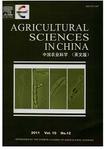Embolism Occurrence in Relation to Water Supply in Xylem of Winter Wheat Leaves
Embolism Occurrence in Relation to Water Supply in Xylem of Winter Wheat Leaves作者机构:InstituteofCerealandOilCropsHebeiAcademyofAgriculturalandForestrySciencesShijiazhuang050031P.R.China
出 版 物:《Journal of Integrative Agriculture》 (农业科学学报(英文版))
年 卷 期:2004年第4期
页 面:30-37页
主 题:Embolism Occurrence in Relation to Water Supply in Xylem of Winter Wheat Leaves
摘 要:Embolism occurrence in the xylem of leaves was investigated in field-grown winter wheat(cv.9195) under droughted and irrigated conditions by ultrasonic acoustic emission (AE)monitoring with drought stress monitor (Model 4615, Physical Acoustics Corp., USA) inthe growing seasons of 1998-2000. The measurements have revealed a pattern of 3 activeAE periods for daily AE signals. The 1st active period generally occurred between 10:00-11:00, the 2nd was often observed around 18:00, and the 3rd was at about midnight, AEsusually ceased after 0:00-2:00. AE rates during these periods varied with soil moisture,weather conditions and growth stages, etc. as shown in Fig. 1. The 3rd one was occasionallymissing on severe drought soils. Irrigation often led immediately to higher AE rates overthe ensued 2nd period. Droughted plants having greater amount of 24 h AEs showed higherdegrees of embolism than the irrigated ones during early jointing stage. However, thetotal of 24 h AEs of droughted wheat decreased by 66 and 82% compared with that irrigatedat middle and late stages respectively. This phenomenon was here termed AE attenuation,which was regarded as an implication of incomplete embolism refilling overnight due tosevere soil moisture depletion. Considerable amount of AE signals were also recordedfrom plants on wet soils. It is suggested by the authors that cavitations and embolismmight be a physiological response to the daily rapid establishment of water potentialgradient within xylem system in the morning, rather than merely a phenomenon resultingfrom water stress.



